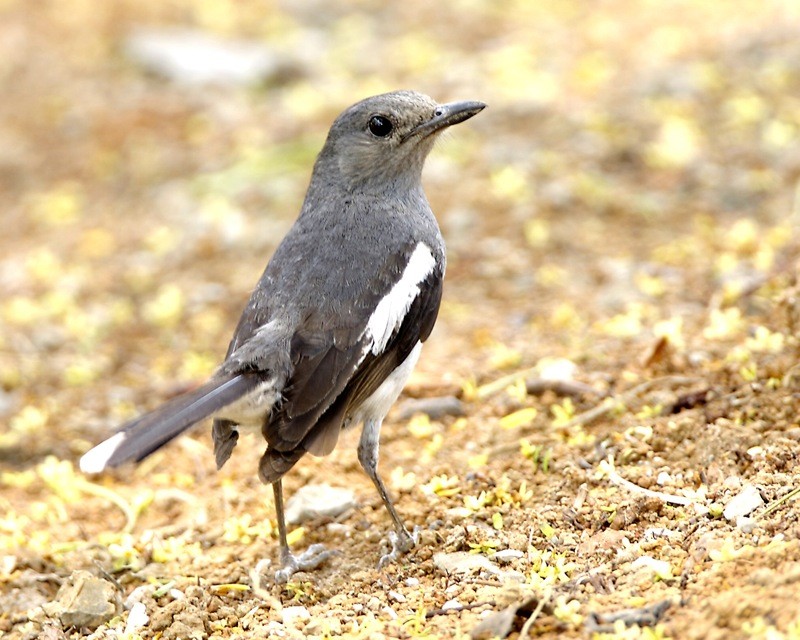Oriental Magpie-robin
A species of Magpie-robins and Shamas Scientific name : Copsychus saularis Genus : Magpie-robins and Shamas
Oriental Magpie-robin, A species of Magpie-robins and Shamas
Botanical name: Copsychus saularis
Genus: Magpie-robins and Shamas
Content
Description People often ask General Info
 Photo By Lip Kee Yap , used under CC-BY-SA-2.0 /Cropped and compressed from original
Photo By Lip Kee Yap , used under CC-BY-SA-2.0 /Cropped and compressed from original Description
This species is 19 centimetres (7.5 in) long, including the long tail, which is usually held cocked upright when hopping on the ground. When they are singing a song the tail is normal like other birds. It is similar in shape to the smaller European robin, but is longer-tailed. The male has black upperparts, head and throat apart from a white shoulder patch. The underparts and the sides of the long tail are white. Females are greyish black above and greyish white. Young birds have scaly brown upperparts and head. It is the national bird of Bangladesh. The nominate race is found on the Indian subcontinent and the females of this race are the palest. The females of the Andaman Islands race andamanensis are darker, heavier-billed and shorter-tailed. The Sri Lankan race ceylonensis (formerly included with the peninsular Indian populations south of the Kaveri River) and southern nominate individuals have the females nearly identical to the males in shade. The eastern populations (Bhutan and Bangladesh) have more black on the tail and were formerly named erimelas. The populations in Burma and further south are named as the race musicus. A number of other races have been named across the range, including prosthopellus (Hong Kong), nesiotes, zacnecus, nesiarchus, masculus, pagiensis, javensis, problematicus, amoenus, adamsi, pluto, deuteronymus and mindanensis. However, many of these are not well-marked and the status of some of them is disputed. Some, like mindanensis, have now been usually recognized as full species (the Philippine magpie-robin). There is more geographic variation in the plumage of females than in that of the males. It is mostly seen close to the ground, hopping along branches or foraging in leaf-litter on the ground with a cocked tail. Males sing loudly from the top of trees or other high perches during the breeding season. 
Size
19 cm
Life Expectancy
10-15 years
Nest Placement
Tree
Feeding Habits
Oriental Magpie-robin primarily consumes insects and other invertebrates, supplemented with fallen fruit, including Oil Palm, and flower nectar. This species forages on the ground or in foliage using its adept hunting techniques, and exhibits a preference for varied food sources within its natural habitat.
Habitat
Oriental Magpie-robin typically inhabits tropical regions with mixed woodlands, cultivated terrain, and areas frequented by humans. Their preferred habitats merge dense evergreen forests with secondary growths like bamboo and Eupatorium odoratum. These birds are also comfortable in human-modified landscapes, including gardens, parks, plantations, and village surroundings. Furthermore, oriental Magpie-robin is drawn to water sources, settling by rivers and in mangroves, extending to altitudes up to 2000 meters but more commonly residing below 1000 meters.
Dite type
Insectivorous
People often ask
General Info
Feeding Habits
Bird food type
Behavior
Magpie-robins breed mainly from March to July in India and January to June in south-east Asia. Males sing from high perches during courtship. The display of the male involves puffing up the feathers, raising the bill, fanning the tail and strutting. They nest in tree hollows or niches in walls or building, often adopting nest boxes. Males are quite aggressive in the breeding season and will defend their territory. 
Distribution Area
This magpie-robin is a resident breeder in tropical southern Asia from Nepal, Bangladesh, India, Sri Lanka and eastern Pakistan, eastern Indonesia, Thailand, south China, Malaysia, and Singapore. They have been introduced to Australia. The Oriental magpie-robin is found in open woodland and cultivated areas often close to human habitations. 
Scientific Classification
Phylum
Chordates Class
Birds Order
Perching birds Family
Old world flycatchers Genus
Magpie-robins and Shamas Species
Oriental Magpie-robin